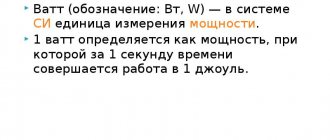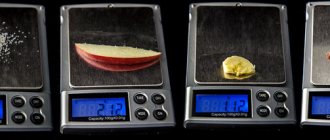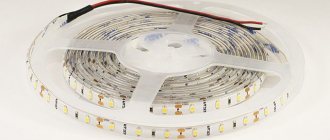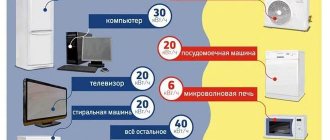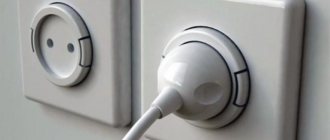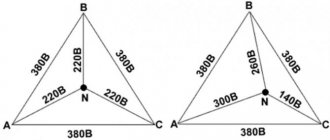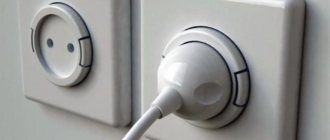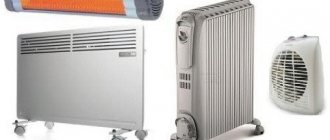Watt and kilowatt - what is it?
The watt is a measurement unit of power, as well as heat flux in physics, sound electrical energy flux, direct current power, active and apparent electric current power, radiation flux and ionizing radiation energy flux in the international measuring system. It is worth pointing out that this is a scalar measurement quantity, that is, measured and calculated.
Description from the reference book
To make it convenient to use watts, the international system has adopted the use of prefixes that determine the decimal multiple of the original indicator. As a rule, kilowatt is used for it. Translated from Greek, the prefix kilo means thousand. The use of a prefix means an increase in the original value by 103 times.
Note! KWh is a non-systemic unit of measurement that shows when energy is produced or consumed and in what quantity. It also shows mechanical work done and heat. Used to measure household electrical energy consumption or measure electrical energy production in the energy sector.
What is measured in these units
Megawatts are used to refer to large receivers or generators of electrical energy. The average coal power plant produces in the region of 600 MW.
Installed electrical capacity of the largest state district power plants in Russia in MW:
- Kostroma State District Power Plant, 3600;
- Ryazanskaya GRES, 3130;
- Konakovskaya GRES, 2520.
Megawatts are used not only to indicate the productivity of large energy facilities. A similar dimension is also common in the housing and communal services system and large industrial facilities. Thus, a high-rise multi-apartment residential complex is capable of consuming several MW of electricity to ensure the operation of lighting and air conditioning systems.
You might be interested in How to connect capacitors
An electric locomotive has the ability to consume up to 12 MW of electrical energy, and a single nuclear power plant can produce up to 1,200 MW or more. The largest nuclear power plant in Russia is Kursk NPP-2 - 1255 MW of one unit. Today in Russia, ten operating nuclear power plants use 35 power units with a capacity of more than 29,000.0 MW.
Total installed capacity of UES of Russia facilities
For your information! Due to concerns about the storage of nuclear waste and harmful emissions from coal-fired power plants, the global energy sector is currently expanding capacity to generate electricity from non-traditional sources using solar and wind. The unit capacity of such installations is more than 21,000 MW of solar energy.
A kilowatt is equal to 1000 watts. This dimension is used mainly to express the power consumption of electric motors, electric boilers, heaters and radio transmitters, household electrical appliances and water heaters.
How to correctly convert these units
A watt is equal to a kilogram multiplied by square meters and divided by cubic seconds. The prefix kilo denotes multiplication by 1000. The same principle applies to power indicators, that is, 1 kW contains 1000 W and 1000 volts. This means that 1 unit = 0.001 subunits. That is, if you convert the power, then a 3 kW electrical appliance will be equal to 3000 W.
You might be interested in what power is the 16a machine designed for?
Conversion formula
In electricity
To simplify measurements in electricity, a subunit is used. You can find out how many watts are in a kilowatt and convert the units by multiplying watts by 103 and dividing by 1000. To carry out the reverse conversion, you need to multiply kW by 103 or multiply known indicators by 1000.
Quantities in electricity
In heating
To measure thermal power, you need to use the joule. This is the work done by 1 newton per 1 meter. To convert joule to kW, you need to use the joule subunit. There are 0.239 kcal in 1 kJ. There are 4.1868 kJ in 1 kcal. There are 860 kcal in 1 kW. This means that 1000 kcal contains 1.163 kW per hour.
Heating measurements
How many kilowatts are in one megawatt?
Megawatt power P (MW) is equal to kilowatt power P (KW) divided by 1000: P (MW) = P (KW) / 1000.
How many KW in 1 MW
For example, to convert 10 KW to megawatts, you need P (MW) = 10 kW / 1000 = 0.01 MW.
To convert kilowatts KW to megawatts MW, simple ratios are used:
- 1 MW = 1000 KW;
- 1 KW = 0.001 MW.
A simple table to find out how many kilowatts are in a megawatt or to convert KW/MW:
- 0 KW - 0 MW;
- 1 KW - 0.001 MW;
- 10 KW - 0.01 MW;
- 100 KW - 0.1 MW;
- 1000 KW - 1 MW;
- 10,000 KW - 10 MW;
- 100,000 KW - 100 MW;
- 1,000,000 KW - 1000 MW.
Converter
To calculate the values, you can use an easy-to-use converter. Converter is a system that converts source data into a given value. All the user needs to do is paste the available data into the field and press the start button on the service being used.
Note! There are different system converters. Some convert these watts, and some directly into kilowatts.
Convector
GHS and non-systemic units
| kilowatt to gigacalorie per second |
| kilowatt to kilocalorie per second |
| kilowatt to calories per second |
| kilowatt to gigacalorie per minute |
| kilowatt to kilocalorie per minute |
| kilowatt to calories per minute |
| kilowatt to gigacalorie per hour |
| kilowatt to kilocalorie per hour |
| kilowatt to calories per hour |
| kilowatt to boiler horsepower (hp(S)) |
| kilowatt to electric horsepower (hp(E)) |
| kilowatt to hydraulic horsepower |
| kilowatt to mechanical horsepower (hp(I)) |
| kilowatt to metric horsepower (hp(M)) |
| kilowatt to kilogram-force meter per second (kgf*m/s) |
| kilowatt to joule per second |
| kilowatt to joule per minute |
| kilowatt to joule per hour |
| kilowatt to erg per second |
| kilowatt to metric refrigeration ton (RT) |
| kilowatt to frigoria per hour (fg/h) |
Units: gigacalories per second / kilocalories per second / calories per second / gigacalories per minute / kilocalories per minute / calories per minute / gigacalories per hour / kilocalories per hour / calories per hour / boiler horsepower (hp(S)) / electric horsepower power (hp(E)) / hydraulic horsepower / mechanical horsepower (hp(I)) / metric horsepower (hp(M)) / kilogram-force meter per second (kgf*m/s) / joule per second / joule per minute / joule per hour / erg per second / metric refrigeration ton (RT) / frigoria per hour (fg/h) » open »» collapse »
Examples in nature and technology
| Magnitude | Description |
| 10−9 watt | Radiation with a power of approximately 1 W falls on an area of the Earth's surface with an area of 1 m² from a star with a brightness of +1.4 magnitude. |
| 5⋅10−3 watt | The radiation of conventional laser pointers has this power (or close to it), which is relatively safe for human vision. |
| 1 watt | Approximate transmitter power of a typical mobile phone. |
| 1⋅103 watt | Small heater. The approximate power of radiation incident on 1 m2 of the Earth's surface from the Sun at its zenith. Average annual power consumed by a single US household (average energy consumption - approximately 8900 kWh/year)[5]. |
| 6⋅104 watts | A passenger car with an 80 horsepower engine. |
| 1.2⋅107 watts | Electric train Eurostar. |
| 8,212⋅109 watts | Power at peak loads of the world's largest nuclear power plant, Kashiwazaki-Kariwa (Kashiwazaki, Japan). |
| 2.24⋅1010 watts | Design capacity of the world's largest hydroelectric power station "Three Gorges" (Sanxia, China). |
| 1012 watts | Peak power of an average lightning strike. |
| 1.9⋅1012 watts | Average estimated electrical power consumed by humanity in 2007[6]. |
| 1.5⋅1015 watt | Record power of pulsed laser radiation achieved at the Nova installation in 1999[7]. The pulse energy was 660 J, the pulse duration was 440⋅10−15 s. |
| 1.74⋅1017 watts | Based on the average irradiance on the Earth's surface of 1.366 kW/m²[8], the total flux of solar radiation on the Earth's surface is approximately 174 PW. If the Earth did not re-radiate this energy into space, it would become more massive by 1.94 kg every second. |
| 3.828⋅1026 watts | Scientists estimate the total radiation power of the Sun to be 382.8 W, which is more than two billion times more than the power of radiation incident on the surface of the Earth. In other words, due to thermonuclear reactions in the center of the Sun, our star loses mass in the amount of 4,260,000 tons every second [9]. |
British and American units
| kilowatt to American refrigeration ton (USRT) |
| kilowatt to British thermal unit per second (BTU/s) |
| kilowatt to British thermal unit per minute (BTU/min) |
| kilowatt to British thermal unit per hour (BTU/hr) |
| kilowatt to foot pound-force per second (ft*lbf/s) |
Units: US refrigeration ton (USRT) / British thermal unit per second (BTU/s) / British thermal unit per minute (BTU/min) / British thermal unit per hour (BTU/hr) / foot pound-force per second (ft *lbf/s) » open »» collapse »
Conversion table for watt to kilowatt
The measured values presented in the table below will help you calculate the energy used by a specific device and make other mathematical calculations in the electrical field.
Table
In general, a kilowatt is a sub-quantity of a watt, the symbol for power. You can correctly convert W to kW in electricity and heating using the conversion formula, table and special online calculator.
Kilowatt and kilowatt-hour - what's the difference?
Along with the designation kilowatt, you can find the unit kilowatt per hour. For example, electricity meter readings are displayed in kWh values. Non-specialists do not distinguish between these concepts and believe that they are one and the same thing. However, these are completely different quantities.
Watt per hour is the amount of electricity produced or consumed per unit of time, denoted Wh.
For example, 1 kW hour means that the power receiver consumes 1 kW of electricity in 1 hour.
Kilowatt, unlike kWh, is a quantity indicating instantaneous power consumed or generated.
The difference between kilowatt and kilowatt∙hour
In electrical engineering there is a quantity called kilowatt∙hour, which is measured by electric meters. Many people substitute concepts, not seeing the difference between the definitions of “kilowatt” and “kilowatt∙hour”, considering the quantities to be one parameter.
Despite the similarity of names, these are completely different quantities. Kilowatt hour is used to measure the amount of electrical energy produced or consumed per unit of time. In particular, the consumption of an electrical receiver of 1 kW∙hour denotes the energy consumed by a consumer with a power of 1 kW for 1 hour. In contrast, a kilowatt is a unit of power that denotes the intensity of generation or consumption of electricity.
Example: A recessed LED luminaire is equipped with a 35 W LED lamp. For 1 hour of operation it consumes 35 Wh of electricity, for 2 hours, respectively, 2x35 = 70 Wh. With continuous operation for 5 days/120 hours, the electricity consumption of the lamp will be 35x120=4200 W∙hour or 4.2 kW∙hour.
What is watt
The unit value of electrical energy for the work done over a period of time is called a watt.
Named after the mechanic and inventor James Watt. Denoted by W or W. He was the first to propose the use of horsepower as a universal unit of measurement of machine performance.
Can be represented by the formula:
W = joule/second, or 1 W = 1 J/sec.
To determine the power of electrical machines, the following formula is used:
P=U*I. Voltage times current.
Electricity is measured by "U" in volts and "I" in amperes by the resulting power in watts.
Relation to base and multiple units of power
Watt refers to a derived unit of power, so in practice it is sometimes necessary to determine the value of the parameter in relation to the basic units of the international SI system. In technical calculations, the following correspondences to the basic quantities are used:
- W = kgm²/s³;
- W = Hm/s;
- W = VA.
The parameter has universal application and is equally used in technical developments in a wide variety of fields.
In heat engineering, a unit of measurement of thermal power of 1 cal/hour, which is not included in the international SI system, is used. Our value under consideration is related to it by the ratio: 1 W = 859.85 cal/hour.
Often, for the convenience of handling large amounts of power from power plants and power units, the word watt can be used with the prefixes “mega” or “giga”:
- megawatt is denoted MW/MW and corresponds to 106W;
- gigawatt (abbreviated GW/GW) is equal to 109W.
On the contrary, in low-current information networks, electronic gadgets and modern electronic equipment, power is measured in fractions of a watt:
- milliwatt (mW, mW) is 10-3 W;
- microwatt (μW, µW) equals 10-6 W.
Using these relationships, you can always convert most parameters into the required power units.
What is a "kilowatt-hour"?
Kilowatt hours are units used to measure the amount of energy consumed by an electrical appliance in one hour. For example, consider the operation of a computer with a power of 0.67 kW. Let's say he worked for two hours. How much electricity did he use during this time? Everything is very simple: multiply 0.67 kW by two hours and get 1.34 kWh. An ordinary 100 W incandescent lamp consumes 0.1 kWh of energy per hour, respectively, if it is not turned off during the day, it will consume 2.4 kW.
Sources
- https://oschetchike.ru/elektroenergii/skolko-vatt-v-kilovatte
- https://rusenergetics.ru/polezno-znat/skolko-vatt-v-kilovatte
- https://knigaelektrika.ru/teoriya/kak-perevesti-kilovatty-v-vatty.html
- https://PoUchetu.ru/interesnoe/skolko-vatt-v-1-kvt
- https://www.calc.ru/kilovatt-v-vatt.html
- https://electrikagid.ru/electrobezopastnost/poschitaem-skolko-vatt-v-kilovatte.html
- https://amperof.ru/teoriya/skolko-vatt-v-kilovatte.html
How to calculate the total power of household appliances
The installed power of a house or cottage is important when calculating and selecting electrical wiring and machines. Without this parameter it is impossible to design the power supply of the house.
To find out the installed power, you need to select data on power consumption from the equipment passports. For example, as indicated on the plate.
| Name | Power, W |
| TV | 150 |
| Boiler | 1 500 |
| Electric furnace | 2 000 |
| Washing machine | |
| Fixtures (total number of light bulbs in the entire house) | 1 000 |
| Computer | 100 |
| TOTAL: | 3,750 W or 3.75 kW |
To correctly calculate the power supply of a house, the combination coefficient is taken into account. It indicates how many consumers are working simultaneously.
For installed power in a house, cottage, apartment up to 14 kW, a coefficient of 0.8 is used in the calculations. That is, the total value of the loads is taken and multiplied by 0.8. For our example, in the calculations we take a power equal to 3.75 * 0.8 = 3 kW.
Main household energy consumers
Climate change and environmental degradation force us to think about saving energy at all levels. Many are making targeted efforts to reduce electricity consumption. To effectively save energy, you need to identify which appliances consume the most.
Of the main consumers of electricity, devices that operate continuously or for many hours attract attention. These include refrigerators and boilers. They can also include heating and heating systems. The next most energy consuming devices are lighting fixtures and water supply systems. Another group that deserves attention are powerful devices that work sporadically, but consume a lot of energy. This group includes vacuum cleaners, floor polishers with steam cleaning function, washing machines and dishwashers, as well as construction and installation tools.
Manufacturers of household and industrial appliances are constantly working to reduce energy consumption. About 25 years ago, a desktop computer consumed about 12 kWh per day. Today, this level is typical for powerful workstations or productive gaming desktops. A standard office PC consumes 2 kWh per day.
Refrigerators no older than 5 years require 1-1.5 kWh of energy per day. This value depends on the ambient temperature and the volume of the cooled space. An oil radiator, which is used as additional room heating, will increase consumption by 7-15 kWh, depending on the characteristics of the building and the outside temperature.
Other devices do not make a large contribution to the total consumption of electrical energy, with the exception of one-time work.
Converting watts to kW
For example, on the iron it says 2000 Watt (W) this means 2 kW, another example with a 100 watt light bulb when converted to kW we get 0.1 kW, therefore:
1 kW = 1000 Watts
By analogy, other meanings can be translated:
You can also convert 1, 2, 3, 4, 5, 6, 7, 8 kW, etc. to watts:
Power(Watt)Power(kW)
| 1000 | 1 |
| 2000 | 2 |
| 3000 | 3 |
| 4000 | 4 |
| 5000 | 5 |
| 6000 | 6 |
| 7000 | 7 |
| 8000 | 8 |
Main household energy consumers
Nowadays, even wealthy people are thinking about reducing energy costs - instead of conventional incandescent lamps in homes, you can increasingly see LED and energy-saving light bulbs. When choosing household appliances, you should pay attention to their efficiency. Almost every home has an iron, electric kettle, TV, refrigerator, etc. The refrigerator usually operates 24 hours a day, its consumption rate is 0.8-1.4 kW, depending on the size and temperature in the room. The daily electricity consumption of a TV is 2.5 kW, and that of a computer is 13.6 kilowatts. An electric kettle will consume 1 kW of energy in 20 minutes of operation. How much energy is consumed in your home?
